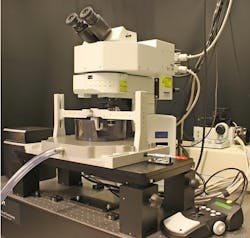A collaboration between Prior Scientific (Rockland, MA) and Neurotar (Helsinki, Finland) produced a seamlessly integrated solution for in vivo microscopy in the brain of awake and moving rodents. The Mobile HomeCage solution, based upon Prior's stable and adjustable Z-Deck platform, is an accessory device for microscopy and electrophysiology that enables high-precision tests in the brain of awake, head-fixed, but otherwise freely moving rodents. The system fits into most imaging setups without the need for modifications, and allows combining neurophysiological techniques (such as in vivo two-photon microscopy, optogenetics, intrinsic optical imaging, and in vivo patch-clamp) with behavioral paradigms in a single experiment.
For more information, please visit www.neurotar.com or www.prior.com.
